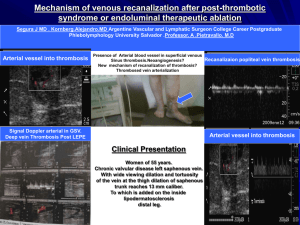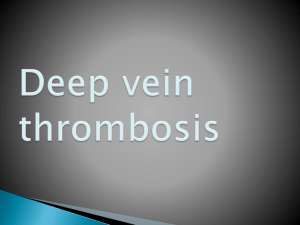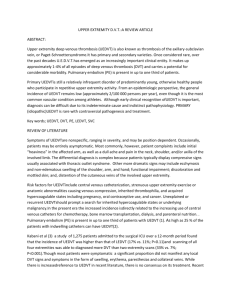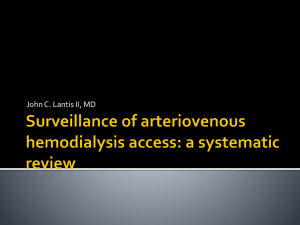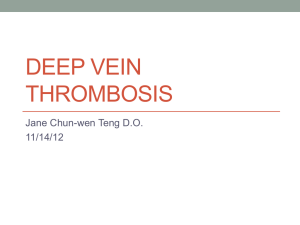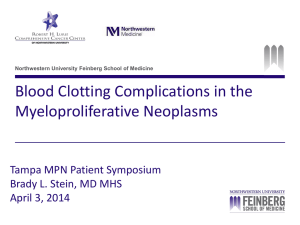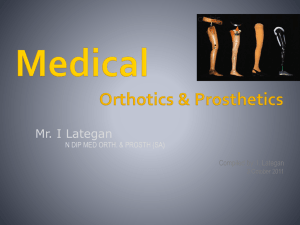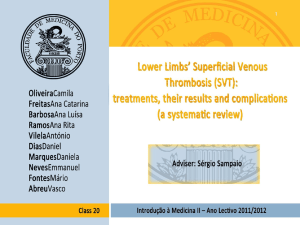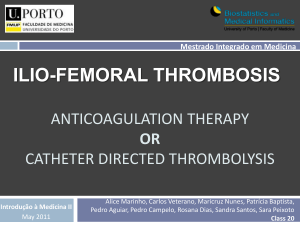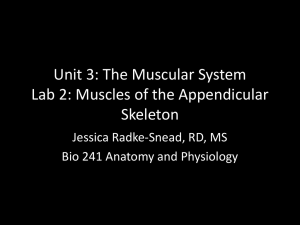Risk Stratification And Incidence Of Acute Complications In Upper
advertisement
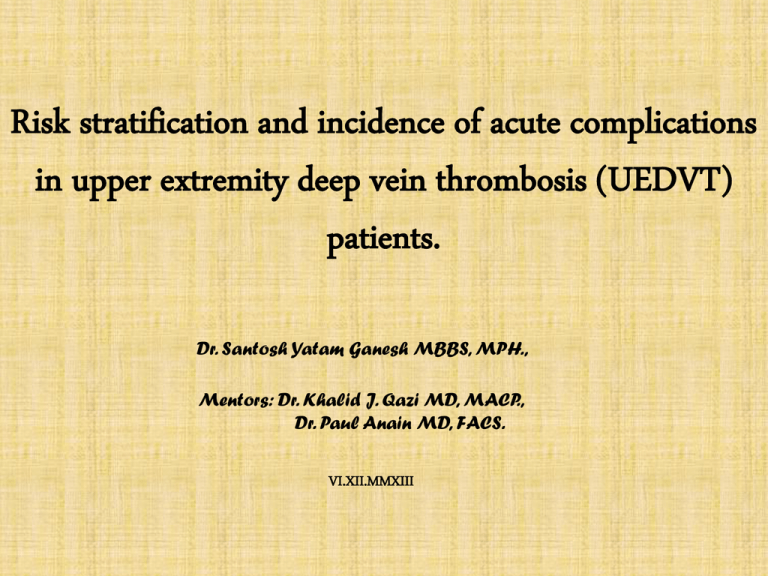
Risk stratification and incidence of acute complications in upper extremity deep vein thrombosis (UEDVT) patients. Dr. Santosh Yatam Ganesh MBBS, MPH., Mentors: Dr. Khalid J. Qazi MD, MACP., Dr. Paul Anain MD, FACS. VI.XII.MMXIII Overview of the presentation • Purpose of research • Epidemiology • Introduction to Upper extremity deep vein thrombosis (UEDVT) • Research design • Results • Discussion • Conclusion Purpose of research • To understand the risk factors of the UEDVT; • To identify complications rate due to UEDVT during the hospital stay; • This study will help optimize patient care and decrease the incidence of UEDVT; Epidemiology • Annual incidence is 0.4-1 per 10,000 people; • Of all the deep vein thrombosis cases, nearly 10% involve upper extremity; • Incidence increasing; – Peripherally inserted central catheter(PICC), – Central venous catheter(CVC), – Malignancy. • Complications are rare; – Pulmonary embolism, – SVC syndrome, – Post thrombotic venous insufficiency. Introduction to Upper extremity deep vein thrombosis (UEDVT) • Defined as a thrombus in any of the upper extremity deep veins. • Deep veins of upper extremity: Radial, Ulnar, Brachial, Axillary, Subclavian, Internal Jugular. • Superficial veins of upper extremity: Digital, Metacarpal, Cephalic, Basilic, Median. Primary • • • Venous thoracic outlet syndrome, Effort-related thrombosis (Paget–Schroetter syndrome) or Idiopathic. Secondary • • • PICC, CVC, Malignancy. • The Computerized Registry of Patients with Venous Thromboembolism (RIETE): – – – – Multicenter study involving Spain, France, Italy, Israel, Argentina Data released by CHEST in 2008 11564 total. 512 had UEDVT. Significant findings compared to lower extremity DVT: • younger age, • Lower BMI, • association with Cancer, • higher overall mortality. – Also more association with PE compared to without UEDVT. • 9% had PE • • • • • • • • • At University of California Recent article One year study Out of 373 patients underwent Ultrasound 94 had DVT Mean age 51 46(49%) had malignancy Pain swelling common symptoms 11 patients had PE Subclavian : most common vein • One year data from 12 hospitals. • Total 483. Out of which 69 had UEDVT UEDVT LEDVT 16 per 10,000 71 per 10,000 AGE: 59 66 • Significantly associated with Central lines, ICU admissions • No difference in 30 days, 6 months and 1year outcomes • No statistical difference in association to cancer Research Question • To find the risk factors in patients with upper extremity deep venous thrombosis; • To find the incidence of acute complications related to upper extremity deep venous thrombosis; Methodology • Study populations was identified using ICD9 codes. • Either admitting diagnosis or diagnosed during the hospital stay. • Retrospective chart review. • Data from last three years. • At Sisters of charity hospital and Mercy hospital of Buffalo. • Used EMR and paper charts. Inclusion criteria : • Adults age above 18. • Patients with newly diagnosed upper extremity deep vein thrombosis. • Diagnosis during hospitalization or at admission. • Confirmatory evidence of diagnosis. Exclusion criteria : • Patients without confirmatory evidence in the imaging will be excluded. • Patients who have chronic deep vein thrombosis with duration greater than 60 days. • Other thrombosis like in lower extremity. Results Total charts : 327 Thrombosis in UE: 272 UEDVT: 187 Excluded: 55 Superficial vein thrombosis: 85 Age Distribution for DVT patients only 3.7 <18.49 18.5-24.99 25-29.99 34.7 32.1 29.4 30-39.99 Mean Weight 80.8 Kgs Mean BMI 28.39 BMI N % <18.49 7 3.7 18.5-24.99 60 32.1 25-29.99 55 29.4 30-39.99 65 34.76 100 90 Veins 90 85 80 84 70 60 50 40 42 30 20 10 0 Axillary Subclavian Brachial Internal Jugular Presenting Signs/Symptoms 160 140 148 120 100 80 60 59 40 20 24 17 0 Swelling Pain Erythema Other DVT Prophylaxis 44(24%) NO Arrived 126(67%) 17( 9%) YES PICC Frequency 82 % 43.9 Cumulative % 43.9 CVC/Dialysis/Mediport 34 18.2 62.0 Pacemaker/AICD 14 7.5 69.5 Unidentified 12 6.4 75.9 none 45 24.1 Total 187 100.0 100 Co-Morbidities N Percentage HTN 121 61.7 Cancer 63 33.7 Dyslipidemia 61 32.6 COPD 58 31 DM 56 29.9 CHF 53 28.3 Sepsis 51 27.3 CAD 46 24.6 Hypothyroidism 38 20.3 CKD 37 19.8 CVA/TIA 20 10.7 H/o Hypercoagulability 18 9.6 Mechanical 7 3.7 COMPLICATIONS DURING THE HOSPITALIZATION 7.5% 4.8% 1.1% PE SVC Other None 86.6% N % PE 14 7.5 SVC 9 4.8 Other 2 1.1 None 162 86.6 Total 187 100 Comparing Upper extremity deep venous thrombosis with superficial venous thrombosis <40 41-50 51-60 61-70 >71 Total Deep VT 12 24 31 37 83 187 Superficial VT 9 10 8 15 43 85 Total 21 34 39 52 126 272 Symptoms DVT(%) SVT(%) p Value Relative risk CI Swelling 148(79) 69(81) 0.699 0.975 .85-1.1 Pain 59(31) 17(20) 0.04 1.57 1.1-2.5 Erythema 17(9) 8(9.4) 0.932 0.96 0.43-2.32 Lines frequency in Deep venous thrombosis and Superficial venous thrombosis patients PICC CVC/Dialysis Pacemaker/ Unidentified /Mediport AICD None DVT 82 34 14 12 45 SVT 25 9 2 2 47 Total 107 43 16 14 92 COMORBIDITY DVT(%) SVT(%) p-value RR CI HTN 121(65) 51(60) 0.45 1.07 0.88-1.32 SMOKING 92(49) 38(44) 0.492 1.10 0.83-1.45 CANCER 63(33) 10(12) <.0001 2.86 1.54-5.30 DYSLIPIDEMIA 61(33) 26(31) 0.73 1.06 0.729-1.56 COPD 58(31) 21(25) 0.28 1.25 0.81-1.92 DM 56(30) 26(31) 0.91 0.97 0.66-O.852 CHF 53(28) 18(21) 0.21 1.33 0.83-2.14 COMORBIDITY DVT(%) SVT(%) p-value RR CI SEPSIS 51(27) 19(22) 0.39 1.2 0.77-1.93 CAD 46(24) 16(19) 0.29 1.3 0.78-2.17 H/o DVT 39(20) 7(8) 0.017 2.53 1.18-5.42 HYPOTHYROIDIS M 38(20) 8(9) 0.004 2.15 1.05-4.42 CKD 37(20) 5(6) 0.004 3.36 1.37-8.25 CVA/TIA 20(11) 8(9) 0.74 1.1.3 0.522-2.47 H/o Hypercoagulable 18(10) 2(3) .05 4.09 0.97-17.23 Frequency of Complications in hospitals For Pulmonary embolism comparing DVT and SVT p Value is 0.211 rr: 2.12, CI: 0.62-7.18 Complications during hospitalization comparing Deep VT vs. Superficial VT p Value: 0.013, rr: 3.78 CI: 1.17-12.2 Discussion Demographics: • Age – 65% of patients are above the age of 65. – Mean age is higher compared to RIETE study. • Gender: – No major difference. • Race: – More common in Whites. – Results are similar to the study done at University at California. • BMI: – Increase in BMI increases risk for UEDVT. – Average weight is higher than other studies. Risk Factors: • Smoking: – Nearly 50%. • HTN, COPD, Cancer, Dyslipidemia: – In more than 1/3rd of patients. • CHF, Sepsis, CAD: – In more than 1/4th of the patients. Investigation tool: • US is the most commonly used diagnostic modality – Sensitivity75-95%. – Specificity 95-98%. Symptoms: • Swelling is the most common symptom. Lines: • PICC, CVC, PACEMAKER/AICD: 75%. • 2/3rd of patients were on DVT prevention prophylaxis with anticoagulants. Comparing UEDVT and Superficial vein: • Pain is associated with UEDVT; • Lines are important risk for UEDVT compared to SVT; • History of previous DVT increases risk for future DVT compared to SVT; • Cancer, CKD and Hypothyroidism are associated with UEDVT than SVT; • Overall more complications from UEDVT during hospital stay; • Study done by Liviu et al (publishes in Chest in 2008) it showed statistically significant association of hypothyroidism and DVT. No studies particularly on UEDVT. • Daneschvar et al study has shown the association between the UEDVT and CKD. They compared the 268 patients with CKD with 4,307 patients with preserved kidney function. 30% Patient with CKD had UEDVT compared to 10 without ckd. • A study at University of California by Jung-Ah lee on 373 UEDVT patients cancer was diagnosed in 48% of patients. We had lesser number of patients with cancer however hospitals we conducted study does not have dedicated cancer floors. Conclusions • Clinical profile of patients with UEDVT and Superficial thrombosis were variable. • Suspect UEDVT compared to Superficial thrombosis – Swelling – Cancer – CKD – Hypothyroidism – With Lines • Patients with UEDVT overall experience more complications than Superficial vein thrombosis during the hospital stay. • First study to find differences in risk factors for Deep vein thrombosis vs Superficial thrombosis in Upper extremity. References 1. 2. 3. 4. 5. 6. 7. 8. 9. 10. 11. 12. 13. 14. 15. 16. 17. 18. Thomas I, Zierler B. An integrative review of outcomes in patients with acute primary upper extremity deep venous thrombosis following no treatment or treatment with anticoagulation, thrombolysis, or surgical algorithms. Vasc Endovascular Surg 2005;39(2):163e74. Muñoz FJ, Mismetti P, Poggio R, et al. Clinical outcome of patients with upperextremity deep vein thrombosis: results from the RIETE Registry. Chest 2008;133: 143-8. Isma N, Svensson PJ, Gottsäter A, Lindblad B. Upper extremity deep venous thrombosis in the population-based Malmö Thrombophilia Study (MATS): epidemiology, risk factors, recurrence risk, and mortality. Thromb Res 2010;125(6): e335-e338. Mustafa, Syed, Paul D. Stein, Kalpesh C. Patel, Todd R. Otten, and Robert Holmes. "Upper Extremity Deep Venous Thrombosis*." Chest 123.6 June (2003): 1953-56. Lee, Jung-Ah, Brenda K. Zierler, and Eugene R. Zierler. "The Risk Factors and Clinical Outcomes of Upper Extremity Deep Vein Thrombosis." Vascular and Endovascular Surgery 46.2 (2012): 139-44. Kucher, Nils. "Deep-Vein Thrombosis of the Upper Extremities." New England Journal of Medicine 364.9 Mar. (2011): 861-69. Illig KA, Doyle AJ. A comprehensive review of Paget-Schroetter syndrome. J Vasc Surg 2010;51:1538-47. Sajid M, Ahmed N, Desai M, et al. Upper limb deep vein thrombosis: a literature review to streamline the protocol for management. Acta Haematol 2007;118(1):10e8. Spencer, Fredrick A., Cathy Emery, Darleen Lessard, and Robert J. Goldberg. "Upper Extremity Deep Vein Thrombosis: A Community-Based Perspective." American Journal of Medicine 2007.120: 678-84. Prandoni P, Polistena P, Bernardi E, et al. Upperextremity deep vein thrombosis. Risk factors, diagnosis, and complications. Arch Intern Med 1997;157(1):57e62. Baarslag H, van Beek E, Koopman M, et al. Prospective study of color duplex ultrasonography compared with contrast venography in patients suspected of having deep venous thrombosis of the upper extremities. Ann Intern Med 2002;136(12):865e72. Merminod, Thierry, Sylvie Pellicciotta, and Henri Bounameaux. "Limited usefulness of D-dimer in suspected deep vein thrombosis of the upper extremities." Blood Coagulation and Fibrinolysis 17.3 (2006): 225-27. Lindblad B, Tengborn L, Bergqvist D. Deep vein thrombosis of the axillary-subclavian veins: epidemiologic data, effects of different types of treatment and late sequelae. Eur J Vasc Surg 1988;2(3): 161e5. Marshall, Peter S., and Hilary Cain. "Upper Extremity Deep Vein Thrombosis." Clinic Chest Medicine 31 (2010): 783-97. Otten T, Stein P, Patel K, et al. Thromboembolic disease involving the superior vena cava and brachiocephalic veins. Chest 2003;123(3):809e12. Sharafuddin M, Sun S, Hoballah J. Endovascular management of venous thrombotic diseases of the upper torso and extremities. J Vasc Interv Radiol 2002;13(10):975e90. Persson L, Arnhjort T, La¨ rfars G, et al. Hemodynamic and morphologic evaluation of sequelae of primary upper extremity deep venous thromboses treated with anticoagulation. J Vasc Surg 2006;43(6): 1230. Ong, B, I Catchpole, R Hetherington, and J Harper. "Peripherally inserted central catheters and upper." Australasian Radiology 50 (2006): 451-54. Special thanks Mentors: Dr. Qazi & Dr. Anain. Guidance: Dr. Woodman & Dr. Tourbaf. Acknowledgement Statistician: Dr. Satchidanand.
